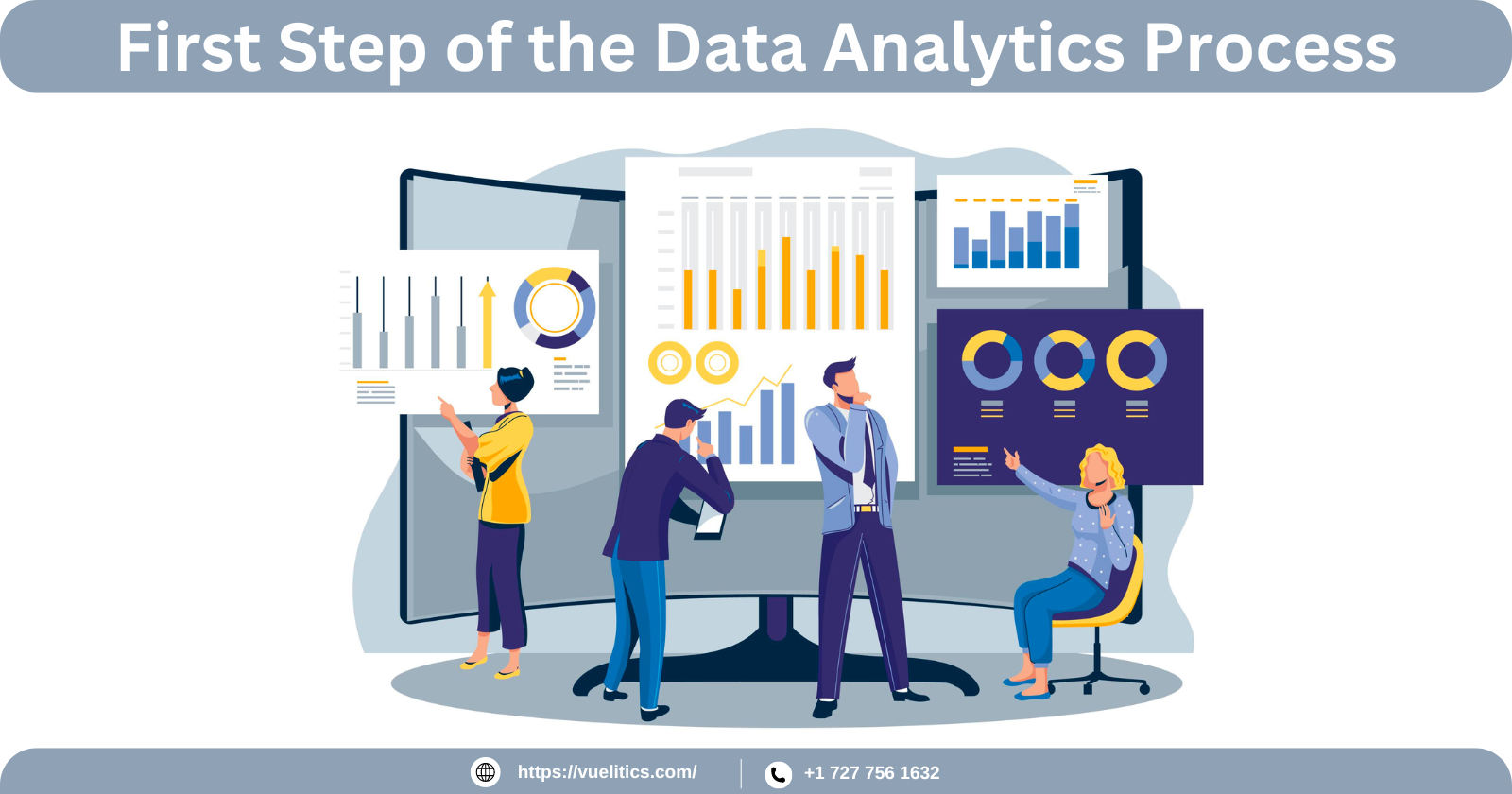What is the First Step of the Data Analytics Process?
 Vuelitics
Vuelitics
Data analytics is a systematic approach to examining data sets to draw conclusions about the information they contain, increasingly with the aid of specialized systems and software. This process is crucial for businesses to make informed decisions, enhance performance, and gain competitive advantages. The data analytics process typically involves several steps, each critical for extracting meaningful insights from raw data. The first step in this process is arguably the most important:
Defining the objective. Let’s explore this foundational step in detail.
What is Data Analytics?
Data analytics is the process of examining data sets to draw conclusions about the information they contain. It helps businesses make better decisions, improve performance, and gain insights.
Key Points About Data Analytics
Understanding Data: Data analytics involves looking at data to understand patterns, trends, and relationships.
Making Decisions: The main goal is to use this understanding to make informed decisions.
Improving Performance: Businesses use data analytics to improve their operations and strategies.
Types of Data Analytics
Descriptive Analytics: Describes what has happened over a given period.
- Example: sales reports that show revenue over the last year.
Diagnostic Analytics: Explains why something happened.
- Example: Analyzing why sales dropped in a specific month.
Predictive Analytics: Predicts what is likely to happen in the future.
- Example: Forecasting next month's sales based on past data.
Prescriptive Analytics: Suggests actions to take.
- Example: Recommending marketing strategies to boost future sales.
How Data Analytics is Used
Business Decisions: Companies use data analytics to make decisions about marketing, sales, and operations.
Customer Insights: Understanding customer behavior to improve products and services.
Operational Efficiency: Identifying areas to cut costs and improve efficiency.
Tools and Techniques
Software: Tools like Excel, SQL, Tableau, and Python are commonly used.
Techniques: Methods include data mining, statistical analysis, and machine learning.
Benefits of Data Analytics
Better Decision Making: Provides a factual basis for decisions.
Increased Efficiency: Helps identify inefficiencies and improve processes.
Competitive Advantage: Gives insights that can lead to a competitive edge.
Understanding the Objective
The first step in any data analytics process is to define the objective clearly. This involves identifying the problem you want to solve or the question you want to answer through data analysis. Without a well-defined objective, the entire analytics process can become directionless and inefficient.
Why Defining the Objective is Crucial
Focus and Direction: A clear objective provides a roadmap for the entire analytics process. It helps in narrowing down the scope and focusing efforts on relevant data and analyses.
Resource Allocation: Understanding the objective allows for better allocation of resources, including time, manpower, and technology.
Expectation Management: Clearly defining the objective helps set realistic expectations for stakeholders regarding what the data analysis can achieve.
Read More: Bi & Data Analytics: Transform Your Business Strategy Now
Steps to Define the Objective
1. Identify the Business Problem
Understand the Business Context: Before diving into data collection and analysis, it’s essential to understand the business context. This involves comprehending the industry, market conditions, and internal factors affecting the business.
Stakeholder Engagement: Engage with stakeholders to gather insights into the business problem. Stakeholders can be executives, managers, or team members who have a vested interest in the outcome of the data analysis.
2. Formulate Questions
Specific Questions: Based on the business problem, formulate specific questions that the data analysis needs to answer. For example, if the business problem is declining sales, the questions could be, "Which products are underperforming?" or "What are the trends in customer preferences?"
Measurable Questions: Ensure that the questions are measurable. This means the questions should be structured in a way that data can provide quantifiable answers.
3. Determine Key Performance Indicators (KPIs)
Relevant KPIs: Identify the KPIs that are relevant to the business problem. KPIs are metrics that help in measuring the performance related to the specific objectives. For example, for a sales decline issue, KPIs might include sales growth rate, customer acquisition cost, and customer lifetime value.
Benchmarking: Establish benchmarks for the identified KPIs. Benchmarks help in comparing the current performance with past performance or industry standards.
4. Define the Scope and Constraints
Scope of Analysis: Clearly define the scope of the analysis. This involves specifying what will be included in the analysis and what will be excluded. For instance, the analysis could be limited to a particular geographic region or a specific product category.
Constraints: Identify any constraints that might impact the analysis. Constraints could be related to data availability, budget, or timeline.
Read More AboutData Analytics in Manufacturing Industry
Practical Example
Let’s consider a practical example to illustrate the importance of defining the objective.
Scenario: E-commerce Business Facing High Cart Abandonment Rate
Business Problem: An e-commerce company is experiencing a high cart abandonment rate, where customers add items to their cart but do not complete the purchase.
Objective: The objective is to understand the reasons behind the high cart abandonment rate and develop strategies to reduce it.
Questions:
At what point in the checkout process are customers abandoning their carts?
Are there any patterns in cart abandonment based on customer demographics?
How does the cart abandonment rate vary by product category?
KPIs:
Cart abandonment rate
Checkout completion rate
Average order value
Scope: The analysis will focus on the checkout process over the past six months and will exclude customers who have abandoned carts but returned to purchase within 24 hours.
Constraints: Limited access to detailed customer demographic data due to privacy concerns.
By defining the objective clearly, the e-commerce company can focus its data collection efforts on relevant data points, conduct targeted analysis, and derive actionable insights to address the high cart abandonment rate.
Conclusion
Defining the objective is the cornerstone of the data analytics process. It sets the stage for subsequent steps, including data collection, data cleaning, data analysis, and interpretation of results. A well-defined objective ensures that the data analytics process is focused, efficient, and aligned with the business goals. As businesses continue to navigate the complexities of the modern data landscape, the importance of this initial step cannot be overstated.
By taking the time to define the objective meticulously, businesses can unlock the full potential of their data, driving informed decision-making and achieving strategic goals.
Ready to take your business to the next level? Discover how our Business Intelligence and Data Analytics services can help you achieve your goals. Contact us at [+1 727 756 1632](tel:+1 727 756 1632) or peter@vuelitics.com.
Subscribe to my newsletter
Read articles from Vuelitics directly inside your inbox. Subscribe to the newsletter, and don't miss out.
Written by

Vuelitics
Vuelitics
Welcome to Vuelitics - Your Business Intelligence and Data Analytics Services Experts in the USA! At Vuelitics, we specialize in turning data into actionable insights that drive success. From collection to visualization, our tailored solutions empower smarter decision-making, fuel innovation, and boost profitability for businesses of all sizes. Join us and unlock the power of your data with Vuelitics - Where Data Drives Success!